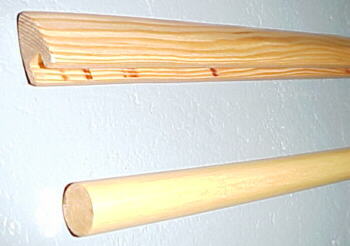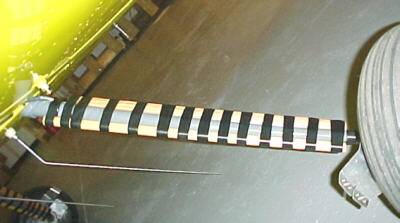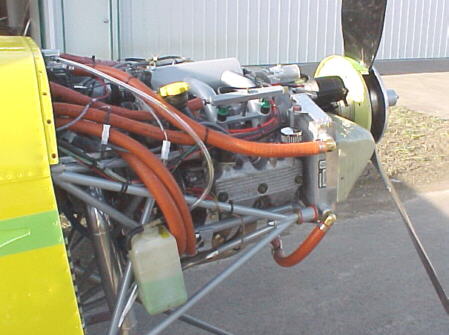

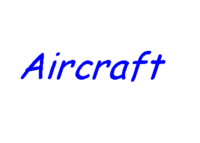
04/23/03

We now have 0.5 hours of ground running the EJ22 turbo. So far, we have encountered a problem with cooling relating to Y plumbing the oil/water cooler. We thought that there might be a problem here. We will temporarily block off water flow through the oil cooler to encourage proper flow through the main rads. The second problem is oil coming out the turbocharger turbine seal. This is either from improper assembly of the turbo unit or a backup of oil from the drain fitting. We hope to isolate this and devise a fix soon.
04/25/03
We now have 0.7 hours on the engine. Blocking off the oil cooler water flow appears to have solved the high water temp problem. Temps stayed at 90C and we have full water flow through both rads now. We'll re-plumb the rads taking the oil cooler out of the loop for now and see how oil temps pan out in further testing.
The turbo was also disassembled and we found a scratched turbine ring seal area, obviously from poor QC at Turbonetics Inc. where the unit was sourced from. This is the second turbo that I have seen from them within one year with damage in this area on brand new units. We are sourcing a new bearing housing from Innovative Turbo to fix this problem.
04/30/03
We've rewired the propeller ammeter to read correctly with the prop in transit in both directions, replaced a UMA manifold pressure gauge which got stuck in the high vacuum region, removed the oil/water heat exchanger and re-routed the coolant lines and are rebuilding the turbo.
05/05/03
Have gone to a larger diameter turbo oil drain after still having some oil discharge from the turbo although this is much reduced after replacing the damaged center section. Have GPS working now. Added remote battery charging plug. Performed max climb angle fuel flow tests with minimum fuel. Have fuel leaks fixed. We now have just over 1 hour of ground running on the engine.
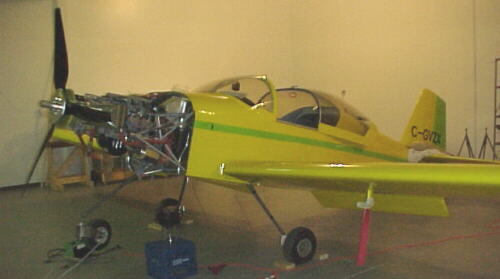
Max climb angle/ minimum fuel flow test
05/12/03
Now have almost 2.5 hours of ground running, testing mainly cooling and turbo oil drain back issues. Have jury rigged a turbo scavenge pump which seems to have solved the oil spitting problem completely. We will be doing a permanent installation with a proper pump later this week. The ground cooling is marginal at present. Instrumentation shows only a 7C drop across the rads at ground idle. We will be testing an electric cooling fan mounted behind one rad this week also. Also being added will be 2 lightweight ventilation blowers as the prop blast proved inadequate for any cooling/ heating flow at idle also. Other plans are to install an air/ oil cooler with thermostat to replace the heavy oil/ water cooler, hopefully total weight gain will be under 3 lbs. for all these mods. Also being worked on are intercom and radio problems plus a new GPS mount for less vibration.
05/13/03
Engine now has over 3 hours of running time. Ground cooling at higher ambient temperatures is still a bit marginal.
05/16/03
Photos of latest additions:
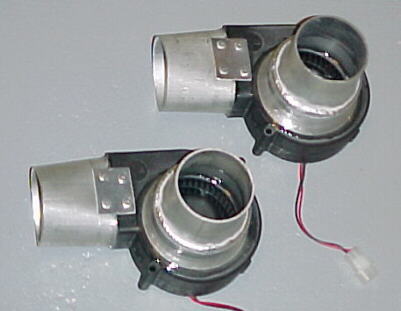
Cabin blower fans, about 1/2 pound each
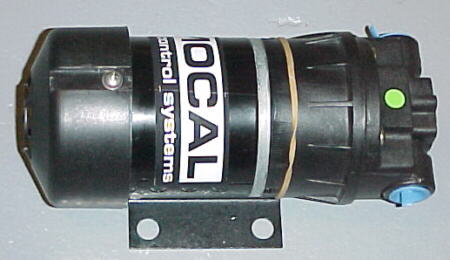
Turbocharger scavenge pump, about 4 pounds
05/27/03
Now have 4.4 hours of ground running. Despite trying some small fans mounted behind the rads, water temps still get up too high.
The new plan is to turn the current right rad into the oil cooler as the oil gets very hot and add another Earls cooler in front of the nose gear with a proper 440 cfm electric fan behind it for water cooling. This will be fed by a 3 inch duct under the right lower cowling. We'll be fitting a Mocal sandwich plate with oil thermostat to adapt lines to the remote cooler.
The ground cooling problems highlight typical difficulties with auto conversions. With the prop geared down 2.2 to 1, low rad surface area available and relatively stagnant air coming off the root of the prop blades, there just isn't enough velocity through the thick rad cores to sink off the heat on the ground. Getting rads mounted further out in the prop arc might help a bit but you will still probably need an electric fan for extended ground running on hot days without exacting a huge drag penalty by going to higher surface area rads.
06/04/03
Have now switched the original right rad to be the oil cooler after flushing with hot water and methanol. Waiting for other parts to mount the second rad and fan. Working on avoinics snags at the moment.
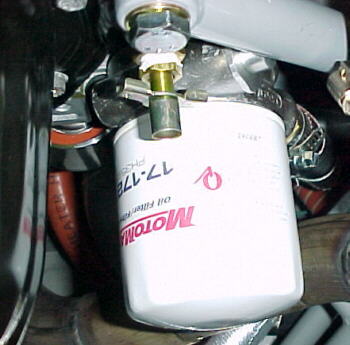

Thermostatically controlled oil cooler sandwich plate and turbocharger scavenge pump
06/12/03
Have the radios and intercom working now. Currently tuning the Navaid Devices wing leveller.
06/22/03
Finally have most of the parts to do the cooling system work. A Spal 440 cfm electric fan and aluminum Ford van heater core are mounted off the nose gear / engine mount and fed via a 3inch duct and SCAT hose. Total rad area is 130 square inches, total rad voume is 321 cubic inches.
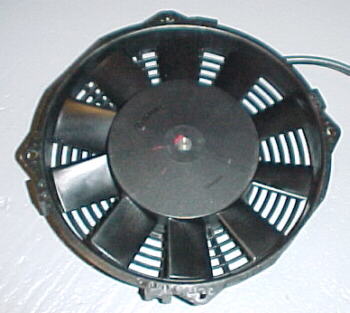
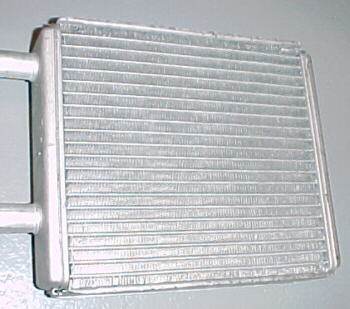
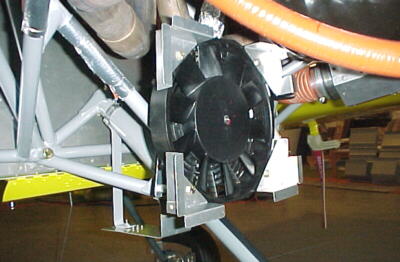
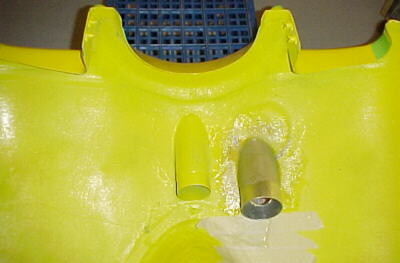
3 inch aluminum tubing glassed in place
Still have to construct a diffuser and vanes to spread airflow over entire core and connect to the SCAT hose.
07/02/03
New rad and fan are installed and we've started running the engine again.
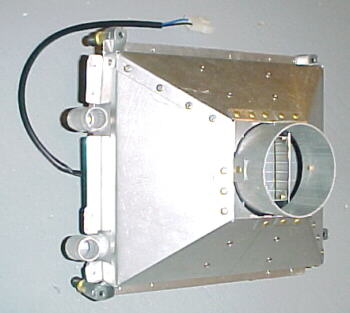
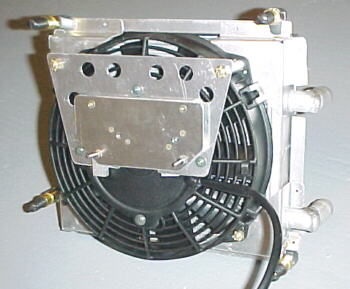
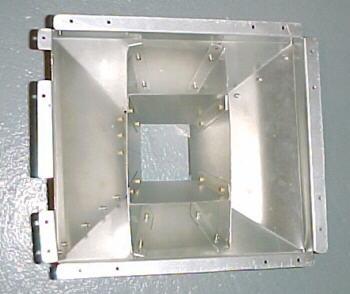
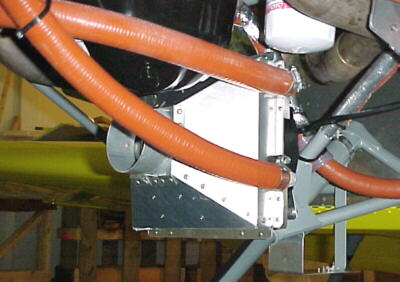
07/06/03
Have switched coolant to 10% glycol, 90% water and added Redline Water Wetter to improve heat transfer. Finally with all the fans switched on, ambient temp 20C, the engine will not exceed 90C coolant temp. Rad exit temp is 85C however so it would be marginal for extended running at higher ambient temps. We ran the engine up to 2500rpm and saw no change in either temp so this was a good sign. Ran for 20 minutes straight so I'm finally, fairly happy.
We ran some additional tuft testing and manometer testing to see pressure differentials (basically zero in ground tests) and make sure air was flowing correctly. If I had to do the rad thing over, I'd be building a P51 style scoop with a big, deep rad, proper diffuser, exit converger and exit flap. This would receive more air from the prop further out in the arc and undoubtedly be more efficient. Looks like we have a workable solution for test flying on cooler fall days and in the winter. We'll be filing for the inspection soon. Now have about 7 hours of ground running on the Subaru engine.
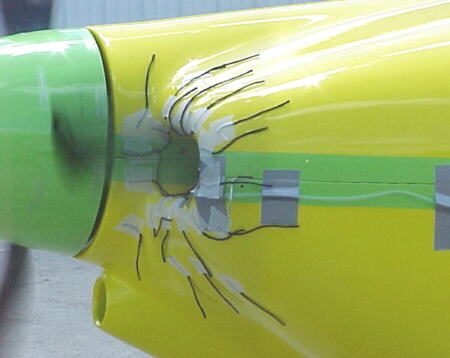
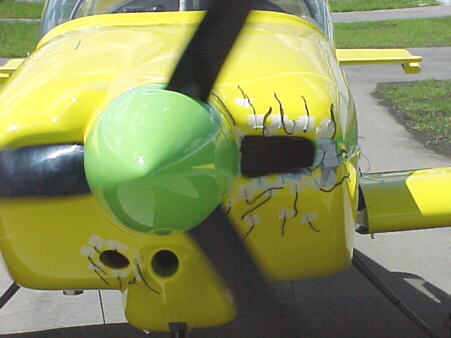
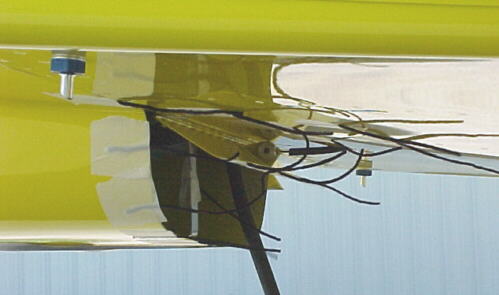
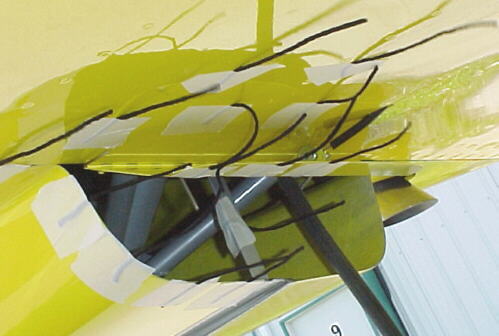
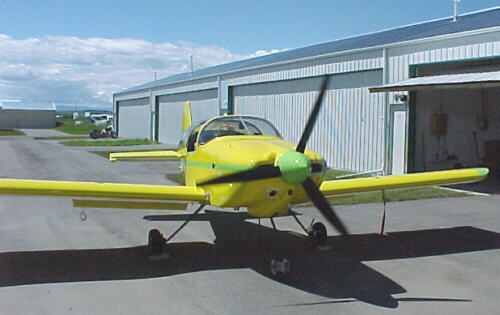
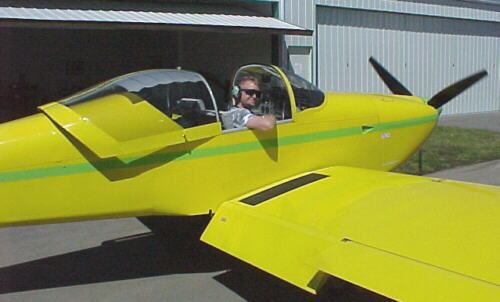
07/10/03
Did some more ground testing yesterday running the engine up to 4000 rpm with the prop in neutral pitch at 37 inches of MP. The aircraft started to climb the chocks. EGTs were below 1100F and mixture looked good after a few adjustments to the SDS programming. All temps and pressures looked good. The engine just sounds great. We've got a couple of narrow vibration periods around 1500 and 3000 rpm which will require further testing on. Next tests will concentrate on propeller pitch changes and rpm vs. MP. Encouraging results so far.
07/14/03
Have about 7.5 hours on the engine now. Tested with the prop in fine pitch. Easily got 5000 rpm (2273 prop) at 35 inches and even with all 3 wheels chocked and brakes on, the aircraft climbed the chocks with the flaps down. At 4000 rpm in neutral pitch, we measured an injector duty cycle of 43% indicating about 125hp here. We can extrapolate hp and MP to show we should get 221 hp at 5500 rpm and 45 inches. Coolant temperatures are staying under 90C on a 22C day. This engine just howls! People come from the other hangars to see it run. We will have to tie the aircraft to a vehicle to test high power setting any more. About to submit the paperwork for the final inspection this week.
07/16/03
Have sent in the papers for the final inspection.
08/22/03
Final inspection is scheduled for Aug. 25. Did some further propeller testing. At 35 inches of manifold pressure in full coarse pitch, we saw 3750 rpm, 4250 at neutral pitch and 5000 in full fine.
08/31/03
Final inspection was passed with no snags. Now awaiting the flight permit. In the meantime, we did first slow speed taxi tests which went well. Takes about 1500 engine rpm (682 prop) to move the aircraft on level ground. Turning circle is impressively tight and brake feel was good. Now have 8.2 hours running time on the engine. Tests were conducted at +25C. Ran the engine for 25 minutes with main and heater fans on before coolant temp reached 90C. Oil temp reached 79C. Next step is some higher power runs in cooler temperatures.
09/26/03
We're working on a solution for improving the ground cooling on hot days adding a minimum of weight. We took some old turbocharger parts and machined them up to use a model aircraft electric motor to drive the compressor. This high performance motor puts out about 0.5 hp at around 20,000 rpm. Current draw is high at 20-25 amps but we hope to get 100 cfm at 10-15 inches of water. This air will be ducted through the heater core. The motor is controlled by an MC-7 DC PWM controller. Hooked directly to a battery, airflow and pressure is very impressive. Weight should be about 3.5 lbs. total. We hope to run some further tests in the near future.
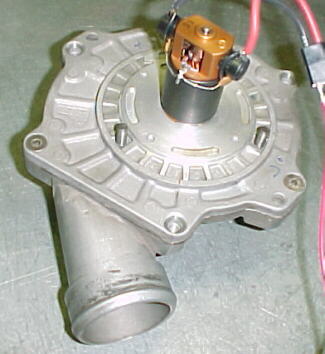
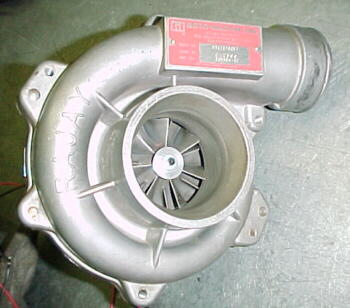
10/08/03
Finally have the flight permit and expect the insurance to arrive shortly so that we can start taxi testing soon.
11/14/03
Have added glycol for winter testing and now completed 12 hours of ground running. High speed taxi tests are planned in the near future, weather permitting. If these uncover no additional problems, flight testing will commence soon after.
11/17/03
Have finally made it out on the runway for fast taxi tests. Initial tests uncovered a severe landing gear harmonic and vibration. There has always been a high frequency harmonic coming from the left landing gear leg even at walking pace. This was erroneously attributed to the wheel pant mounting plates vibrating but was still there with the pants installed. Out on the runway at 20-30 knots, the high frequency vibration turned to a lower frequency, high amplitude vibration which felt like the aircraft would come apart. We retired to the hangar, lowered the tire pressures from 35 to 25 on the main gear, tested the nose fork breakout force to eliminate nose wheel shimmy as a possible cause, then taped a 1 X 2 spruce strip onto each main gear leg. When we went out again, the vibration was 95% cured. Van's suggested in the plans to build these wooden dampening strips. These are VERY important on my aircraft although there are apparently many RVs flying with none and having no problems. Many people are under the impression that these are stiffeners. They actually have a minimal effect on stiffening the leg. Wood is used to dampen the natural harmonic because it has a different modulus than spring steel. The idea is to change the natural harmonic frequency of the leg to a range either above or below where it would occur under standard useage.
We ran the engine up to 4500 rpm and 40 inches and worked up to about 50 knots. Once the prop bites in and the boost comes up, the aircraft accelerates impressively. Rudder authority is very impressive and sensitive. You can turn the aircraft easily at idle power within a 50 foot circle using only rudder. With brake, the airplane turns on a dime. Visibility for taxiing is not as good as many tricycle gear aircraft due to the nose high attitude, but fine once on the runway.
The engine has a bad harmonic at 1500 rpm but this is very narrow. At all other rpms, it is turbine smooth compared to a Lycoming, also much quieter and sounds much better. We now have 14.5 hours of ground running. So far everything system wise works. We reprogrammed some of the engine monitoring system parameters to stop alarms from being triggered. Cooling seems fine on the +5C days we were running although the cabin heater needs to be cycled on the ground from time to time to keep the coolant temp below 90C. This will be addressed once cold, snowy weather precludes flight testing. Runs exceeding 45 minutes have now been done. The checklists have been refined now. Once the new gear leg stiffeners are installed, the fast taxi tests will be completed and the first flight attempted within the next 2 weeks.
11/24/03
The flight ready fir leg dampeners are now installed, ready for further testing.
